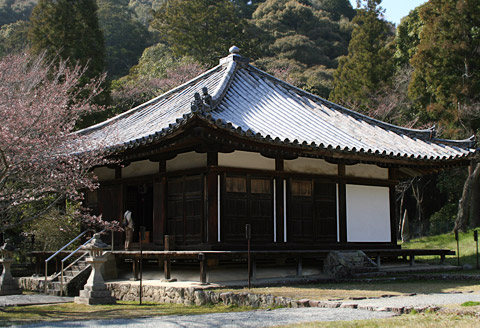|
||
 |
||

Negoroji Daishidou 根来寺大師堂 (Wakayama)
(C)2001 Japanese Architecture and Art Net Users System. No reproduction or republication without written permission.
掲載のテキスト・写真・イラストなど、全てのコンテンツの無断複製・転載を禁じます。
|
||||||
| hougyou yane 宝形屋根 | ||||||
| KEY WORD : architecture / general terms | ||||||
| Lit. roof segments
flowing down on four sides, also
called shichuu yane 四注屋根 shihounagare 四方流. A hipped or pyramidal roof, as for example,
the top roof of a pagoda. When four or more planes converge, the peak is
concealed by a box-like cover *roban 露盤, topped by a precious jewel *houju 宝珠 or, in the case of a pagoda, a finial *sourin 相輪. Since the structural principles are the same, roofs over hexagonal or
octagonal buildings *rokkaku
endou 六角円堂; *hakkaku
endou 八角円堂, are also classified as hougyou yane. They differ only in the number of roof planes. There
are numerous Buddhist halls dating from the Heian period and
later that have pyramidal roofs. Examples: Kakurinji Taishidou 鶴林寺太子堂 (1112) in
Hyougo prefecture, Kaijuusenji Monjudou 海住山寺文殊堂 (13c) in Kyoto, Juurin-in Hondou 十輪院本堂 (early 14c) in Nara. |
||||||
 Negoroji Daishidou 根来寺大師堂 (Wakayama)
|
||||||
| REFERENCES: | ||||||
| *hougyou-zukuri 宝形造 | ||||||
| EXTERNAL LINKS: | ||||||
| NOTES: | ||||||
(C)2001 Japanese Architecture and Art Net Users System. No reproduction or republication without written permission. 掲載のテキスト・写真・イラストなど、全てのコンテンツの無断複製・転載を禁じます。 |
||||||